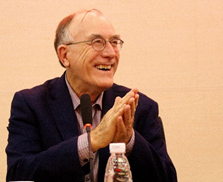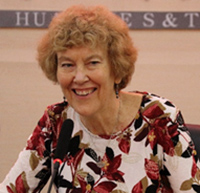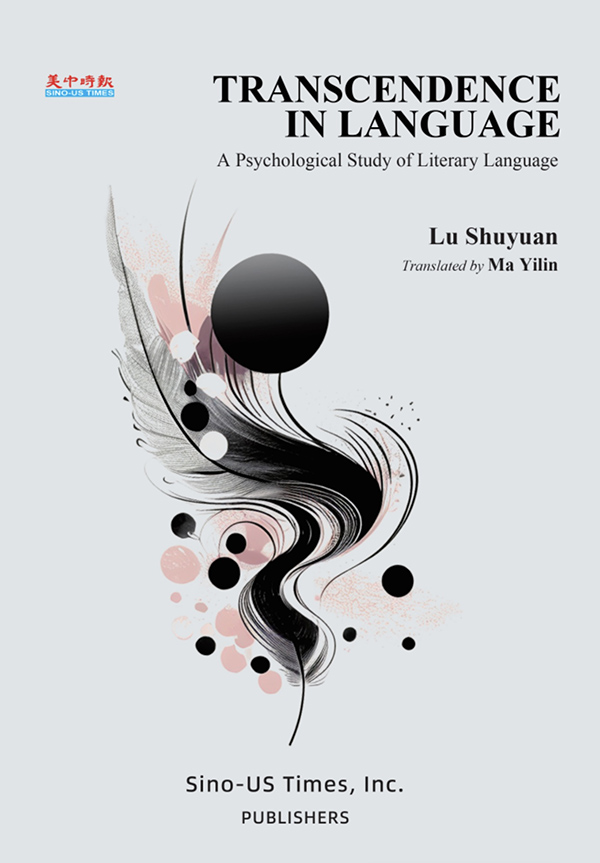美东时间2025年3月29日晚8时,美西时间3月29日下午5时,北京时间3月30日上午9时,来自美国和中国十几所知名高校的专家学者在线上齐聚一堂,共同参加由美国中美后现代发展研究院主办的过程哲学视域下的语言学研究暨鲁枢元教授语言学思想国际研讨会。耶鲁大学约翰·格瑞姆教授与玛丽·伊芙琳·塔克教授在联合发言中说,鲁枢元教授凭借其自由放任之文风,对语言哲学的相关话题进行了探讨,尤其是他所秉持的“敬畏神秘”之姿态,令人耳目一新。


以下是约翰·格瑞姆、玛丽·伊芙琳·塔克发言全文,马伊林翻译:
全息的、生态的、宇宙论的语言学贡献
——读鲁枢元的修订版英译《超越语言》
约翰·格瑞姆、玛丽·伊芙琳·塔克
鲁枢元教授凭借其自由放任之文风,对语言哲学的相关话题进行了探讨,尤其是他所秉持的“敬畏神秘”(鲁枢元,《超越语言》“自序”5)之姿态,令人耳目一新。在《超越语言》一书中,他把研究的焦点放在“文学语言的心理发生”(鲁枢元,《超越语言》“自序”5)层面,亦即文学和诗歌的发生层面——人(抑或人性)如何自发地通过语言同生物圈产生深层次的联系?这一富有创见性的论著,为该研究的推进作出了突出贡献。
鲁教授注意到了早期人类的吟唱及原始语言现象。书中指出,欧洲语言学研究产生出了两个流派:一个是以亨利·柏格森(Henri Bergson)为代表的流派,另一个是以弗迪南·德·索绪尔(Ferdinand de Saussure)为代表的流派。在他看来,柏格森流派强调个人意识的体验,认为直觉可以把握深藏的本质。由此,柏格森流派的理念与“言语”的自发性产生耦合,而“语言”却成为索绪尔流派的代名词。鲁教授也承认,索绪尔的研究是必不可少的,并且是富有洞见的,但其研究对象却侧重于语言“意义与符号的关系”(鲁枢元,《超越语言》3),“[而]不是语言的内容”(鲁枢元,《超越语言》3)。这种理论方法虽然强调了逻辑性和完整性,但却试图清除语言中难以理解的“迷雾”。
在鲁枢元教授看来,索绪尔等结构主义语言学家“努力是要用一种‘无信息的规则’来取代作品中那些‘无规则的信息’”(鲁枢元,《超越语言》14)。他们在文学与诗歌的海洋里撒下了一张沉重的网,拖捞上来的却是“一些庞大的鱼的骨架”(鲁枢元,《超越语言》14)和“一些鱼骨头”(鲁枢元,《超越语言》14)。接下来,他转向对于柏格森的讨论。他把柏格森的研究对象概括为“一种由光线、色彩、声响、言词综合表达出来的感觉和氛围”(鲁枢元,《超越语言》20)。这一视角对于文学语言的研究意义非凡。
鲁教授从文艺复兴时期的画家、哲学家、诗人以及当代的摇滚音乐家那里——这些文学艺术家“开始突破理性主义的樊篱、跨越工业社会的疆界”(鲁枢元,《超越语言》 22)——开启了更富有活力、更具有自发性的语言源泉的探索之旅。他把文学艺术的这一流向称之为“向内转”(鲁枢元,《超越语言》 22):在深刻体验那种着社会意识的大气云层时,向人类内在世界流转。在他看来,文学,尤其是诗歌,能够利用语义和美学信息将人类表达的自发性与文化语言表达的结构联系起来。
鲁教授论及了围绕着语言的起源而反复出现的两个问题:其一,有没有可能解密人类语言究竟起源于何时?其二,如果存在的话,人类语言与动物、昆虫、植物和自然万物的之间存在着一种什么关系?
关于第一个问题,他曾多次论及原始族群的语言现象。在他看来,在原始社会,“在图腾、神话、巫术还充塞着人类的语言领域的时候,人类的语言在‘逻辑’和‘直观’‘理智’和‘情感’‘形式’和‘内涵’‘心灵’和‘手段’诸对立的方面可能出现过最初的统一,即那种‘低层次’上的有机统一”(鲁枢元,《超越语言》 115)。原始语言也将原始族群与富有地域色彩的环境、故事以及生存方式联系在一起。
鲁教授通过将马丁·海德格尔(Martin Heidegger)的“深渊”与后世作家的创作达成契合,以此来描述获得诗意自发性的“裸语言”所必需的心理状态。恰如书中所言,“这里我还希望加上一句:只有那些敢于潜入深渊、并体验着深渊而终于能够浮升到深渊之上的人,才能够言讲出这种真正富有文学魅力的语言。”(鲁枢元,《超越语言》 128)他继而写道,“对于人类语言的研究应该在这个统一的[以及丰富多彩的]系统中进行,而不应囿于结构主义语言学家的成见”(鲁枢元,《超越语言》 154);艺术的语言应被视为“一种内涵更为深厚广阔的语言,一种超越了‘语言’的‘语言’”(鲁枢元,《超越语言》 154),而诗歌的语言(或者诗性语言)即重要一例。这些均体现了鲁教授对于该话题的独到见解。
鲁教授引述恩斯特·卡西尔(Ernst Cassirer)的话:“语言游走于‘不确定’与‘无限’之间的中间境界,把不确定的转化为确定的观念,又把它限制在有限的规定性范围内。”(恩斯特·卡西尔,《语言与神话》80–81) 即便如此,他却认为,即使在这个“中间境界”中,人类语言也具有更大的创造力和超越性。
鲁教授对于结构主义的挑战,哪怕遭受再多的非难,也始终朝向一种超越性的创造力迈进,而这种创造力就诞生于文学的“中间境界”。正如书中所言:“我几乎成了[那些推动文学批评科学化的人眼中]一个罪在不赦的逆种。然而,我仍然坚定地认为,作为一个文学理论家,他的双脚固然必须(实际上也是不得不)跋涉在社会生活的崎岖道路上,而他的双眼却不能不注视着人类精神的空间,而那又是一个流动的、自由的、创造着的、变幻着的空间”(鲁枢元,《超越语言》 160)……就像尼采眼中的“高出了人类和时间6千英尺”(鲁枢元,《超越语言》 160)。正是在这些自我反思的时刻,鲁教授本人获得了一种超越性的洞察力(正如我们所理解他的作品那样)。恰如他本人所言,文学的精义并不在语词“中”,而是在词“上”形成的,“如同风行水上,自然成文,是一种创造与生成”(鲁枢元,《超越语言》 160)。这是对语言和文学力量的超越性洞察。
关于第二个问题,最为重要的是鲁枢元教授对于文学超越性的研究,同时触及到语言的生态维度。他在书中基于自己划定的地球生态系统的“三分法”——“自然生态、社会生态和精神生态”(鲁枢元,《超越语言》 161)加以分析。紧接着,他还厘清了自己及其所提出的“三分法”同法国哲学家菲利克斯·加塔利(Félix Guattari)及其《三重生态学》(The Three Ecologies,1989)之间的“界限”。他告知读者,恰恰是由于米盖尔·杜夫海纳(MikelDufrenne)的《美学与哲学》(Aesthetics and Philosophy,1976)的启迪作用,才发展出了自己的“三分法”,而在此之前他并没有读过加塔利的那部著述。
实际上,这种“一分为三”的观念在中国传统文化中十分显著:《道德经》中记录下“道生一,一生二,二生三,三生万物”;《易经》视“天、地、人”为“三才”。鲁教授还将他的“三分法”延伸到了文学作品中的语言探秘,详述了三种语言:线型语言、面型语言和场型语言。在他看来,线型语言明显存在于情节的因果叙述中;面型语言用于描述文学“人物、景物、场面”(鲁枢元,《超越语言》 167);场型语言“依赖于表象和意象的自由拼接,它作用于作家和读者的直觉和顿悟……创生出文学作品的境界、氛围、气韵、格调、情致”(鲁枢元,《超越语言》 167)。
鲁教授基于中国诗歌独特的道家美学,凭借中国诗歌的“神韵说”,探讨场型语言的内在深度。书中指出:“在庄子看来,形色声音属‘物之粗者’,只是构成艺术本体较低级的层次;而形色声音之外的那种东西,才是‘物之精者’,才是艺术本体中至高无上的东西。因其外于形质,故又可踞于形质之上,成为一种形而上的、君临于形的东西。”(鲁枢元,《超越语言》 172)
在鲁教授看来,“‘神韵’并不是一种绝对的客观存在,也不是绝对的主观派生物,它是主体与客体相互纽结的网络中的一种状态,是一种非心非物、亦心亦物的现象形态。”(鲁枢元,《超越语言》 174)这是他对场型语言于文学创作生态维度方面的精妙探索。此外,他还饶有兴味地提到,“中国古代,哲学和科学中所讲的‘气’近似于现代科学中所说的‘场’”(鲁枢元,《超越语言》 175)。因此,“场”、“气”和“生态”,是以往的物理学和常规语言学的经验难以状述的。这是一项开创性的工作,为后世学者认识“气”中的动态物质力量提供了重要借鉴。
最后,鲁教授还集中探讨了关涉汉字的语言学问题。他引述了20世纪中国作家鲁迅先生的观点,证实了汉字的空间构成性在文学审美过程中的重要作用:当作家用汉字展示山川河流、海洋、丛林和鱼类时,读者几乎会通过汉字的历史演变看到真实的物象。在鲁迅先生看来,汉字有“三美”——“意美以感心,一也;音美以感耳,二也;形美以感目,三也”(鲁迅,《鲁迅全集》344)。此外,鲁教授还对成中英教授的论见秉持赞同之姿:“中国语言是文法、语义、语用三者的结合,三者的同一,只重视词与词之间的定位关系,个别元素与整体意义互相决定,是一种非线性的‘意义网’,是一种全息的宇宙论语言,是一种‘有机场论’型的语言。”(鲁枢元,《超越语言》 249)
当然,“意义网”(鲁枢元,《超越语言》 249)这个词,亦可概括为鲁教授在《语言超越》中所做出的全息的、生态的和宇宙论的贡献。这部开创性的作品为读者带来了这样的启迪:语言文字——通过借助于同内心深处的直觉感悟而产生共鸣的文学作品——将我们与自然重新联系在一起。
我们谨对这部大作的修订出版,对这部杰作的英文版的面世表示最为热烈的祝贺!
(本文的原标题为“鲁枢元教授的《超越语言》:赞赏性的概览”(Transcendencein Language by Professor Lu Shuyuan: An AppreciativeOverview)。为了适应汉语的阅读习惯,抽取本文末尾一句概括性的文字作为正标题,同时重新添加了副标题。此外,在翻译的过程中,还对正文中的几处词句进行了微调,不再说明。—-译者注)

TRANSCENDENCE IN LANGUAGE
APsychological Study of Literary Language
Lu Shuyuan
Translated by Ma Yilin
Sino-US Times, Inc.2024
约翰·格瑞姆 (John Grim) ,耶鲁大学林业与环境研究学院教授,美国著名原住民问题研究专家,美国德日进研究会主席。格瑞姆教授是著名专题纪录片《宇宙之旅:生命的展开》的主要创作者和制片人。
玛丽·伊芙琳·塔克(Mary Evelyn Tucker),耶鲁大学林业与环境研究学院教授,世界范围探讨儒学生态维度的领军人物,也是哈佛大学著名论坛“世界宗教与生态论坛”主持人、《世界宗教与生态》丛书主编。出版的著作有:《气的哲学》《儒家与生态》《道家与生态》《佛教与生态》等,汉译本已在中国出版。2008年世界荣获著名生态文明奖“柯布共同福祉奖”。
马伊林,兰州大学外国语学院讲师,中国人民大学与美国加州大学伯克利分校联合培养博士,《超越语言》英文版的译者,其研究方向为英美文学及翻译学。
附约翰·格瑞姆教授和玛丽·伊芙琳·塔克教授的原文
Transcendence inLanguage by Professor Lu Shuyuan: An AppreciativeOverview
John Grim and MaryEvelyn Tucker
(Yale Forum onReligion and Ecology)
How refreshing tohave Professor Lu Shuyuan’s free-style philosophical discussions of linguisticsand especially his holding to “awe and veneration in mystery” (Lu Shuyuan, Transcendence inLanguage ii). His chosentask in Transcendence inLanguage is to examine “thepsychogenesis of literary language” (Lu Shuyuan, Transcendence in Language iii). That is, thegenesis of literature and poetry as insights into the profound connections ofhumanity through language to the spontaneities of the larger biosphere. Lu’sbook is a unique and invaluable contribution to this discussion.
Attentive to thechants and formative language of early humans, Professor Lu see two lineages inthe European study of language which he associates with Henri Bergson andFerdinand de Saussure. Lu sees the Bergson-lineage as emphasizingindividual conscious experience open to intuition as grasping a deeply hiddenessence. He identifies this lineage with the spontaneities of “speech.” Onthe other hand, Lu identifies langue / language with the lineage from Saussure. While validatingSaussure’s work as necessary and insightful, Lu sees it as research into “themeaning and the symbol instead of the content of language” (Lu Shuyuan, Transcendence inLanguage 3). Thistheoretical approach emphasizes the logicality and integrity attempting toclear the incomprehensible “mists” of language.
For Lu thelinguistic structuralism of Saussure and others “try to replace the ‘irregularinformation’ [of languages] with the ‘informationless regulations’” (LuShuyuan, Transcendence in Language 12) that cast aheavy net gathering in “some huge fishbones and skeletons” (Lu Shuyuan, Transcendence inLanguage 12). On the otherhand, Lu explores the lineage from Bergson whose research, he suggests, pointstowards “an atmosphere or a feeling expressed by the overall complex of thelight, the color, the sound and the word” (Lu Shuyuan, Transcendence inLanguage 16-17). This is aninvaluable perspective he is offering.
Lu discusses thismore vital and spontaneous search for a dynamic well-spring of language withRenaissance painters, philosophers, poets, and contemporary rock musicians who “breakthe obstacle of rationalism and the border of industrialism” (Lu Shuyuan, Transcendence inLanguage 18). This lineage,then, identifies an “‘inward’ turn” (Lu Shuyuan, Transcendence in Language 18) towardssubjectivity in deep experience of that atmospheric cloud embracing the largersocial consciousness. Thus literature, and poetry especially, draw on semanticand aesthetic information to bridge the spontaneities of human expression withthe structures of cultural linguistic expression.
Lu tackles tworecurring questions regarding the origins of language. First, is it possible todiscover the origins of human language? Second, what is the relationship, ifany, of human speech to animal-insect-plant-material sounds?
Regarding theformer origins of language, Lu often refers to Indigenous peoples in theprimitive time. He insightfully says of these diverse peoples that their “language,[is] full of totems, myths and witchcrafts, may be an original, dialectical and[an] organic unity of the opposites, including logic and visualization,intellect and emotion, form and content, and spirit and method” (Lu Shuyuan, Transcendence inLanguage 84). It is alsothe case that Indigenous languages connect people to local places, stories, andpresences.
With the literaryproduction of later writers, Lu relates to the abyss of Heidegger as a way ofdescribing what psychological states are necessary for attaining the “nakedlanguage” of poetic spontaneities. He writes: “On the basis of Heidegger, Iwould like to add, only those who dare to place themselves into the abyss andclimb above the abyss, can write the genuine language full of literary charm” (LuShuyuan, Transcendence inLanguage 95) .Thus, hewrites, “The study of human language should not be confined to the narrowpreconceptions of the structural linguists but be conducted within the unifiedand ‘colorful’ system…[that is] the language of art can be full of deeper andbroader connotation, and the poetry (or the poetic language) can inevitably beregarded as the typical one” (Lu Shuyuan, Transcendence in Language 116). Thiscaptures the brilliant insight of his book.
Lu cites ErnstCassirer in saying: “Language moves in the middle kingdom between the ‘indefinite’and the ‘infinite’; it transforms the indeterminate into a determinate idea,and then holds it within the sphere of finite determinations” (Ernst Cassirer, Language and Myth 80–81). Yet, healso holds to a larger creativity and transcendence for human language even inthis middle realm.
Professor Lu’schallenges to structural analyses has consistently pointed towards atranscendent creativity that can arises in the “middle realm” of literature evenat the cost of relentless criticism for his position. He writes, “I have almostbecome an unforgivable rebel for… [those] promoting the scientization inliterary criticism. Even so, I remain convinced firmly that an honorableliterary theorist should (and indeed [has] to)… tread the rough roads of sociallife, [and] look up at the sky full of mentality, creativity, freedom andunpredictability, which is similar to ‘six thousand feet above man and time’ inNietzsche’s eyes” (Lu Shuyuan, Transcendence in Language 122). It is inthese moments of self-reflection that Lu himself, as we understand his work,attains a transcendence of insight. Forexample, he reflects that “the essence of literature is not formed ‘in’ thewords, but ‘on’ the words, as the wind walks on the water, naturally andcreatively” (Lu Shuyuan, Transcendence in Language 123). This is a marvelous insight intothe power of language and literature.
Most importantly,in our reading of Professor Lu’s study of transcendence in literature, is hissignificant turn towards the ecological dimensions of language. He deepens hisanalysis here using a “trichotomyto the earth’secosystem, that is, natural ecology, social ecology and spiritual ecology” (LuShuyuan, Transcendence inLanguage 123). Lu notes hisrelationship to the French philosopher, Félix Guattari especially his 1989work, The Three Ecologies. He notes,however, that he had not read Guattari before developing his own “trichotomy” basedon his thinking after reading Aesthetics and Philosophy (1976) by Mikel Dufrenne.
Moreover, thisthreeness is prominent in Chinese traditional thought such as the Tao Te Ching (or Laozi), “Tao gives birthto one, one to two, two to three, and three to all things.” Also, the Yi Jing (or I Ching), has “heaven,earth and human” as a three-dimensional theory. Lu extends his trichotomydetailing three languages in literary works: namely, linear, flat and fieldlanguages. Linear language is evident in the causal narrative of the plot; flatlanguage is descriptive of the literary characters, scenes, and situations;finally, field language “depends on a free combination of presentations andimages… the intuitions and the insights of the writers and the readers, andgenerates a unique realm, atmosphere, style and mood in literary works” (LuShuyuan, Transcendence inLanguage 127).
Lu explores theinterior depth of field language in the “Romantic charm” of Chinese poetryciting its special Daoist characteristics. He observes, “In Zhuangzi’s view,the physical [character of language], especially the sound and the form, istreated as ‘the coarseness of the thing,’ that is, the lower level in artisticnoumenon. As the transcendence in the sound and the form, ‘the essence of thething’ is metaphysically manifested in the higher level in artistic noumenon” (LuShuyuan, Transcendence inLanguage 132).
For Lu, “Romanticcharm is neither an objective existence nor a certain subjective derivation,but a state or a phenomenon in the network where the subject and the object areintertwined, and the mind and the substance are intertwined respectively” (LuShuyuan, Transcendence inLanguage 135). Here is hissubtle exploration of the ecological dimension of literary creativity in fieldlanguage. Moreover, he interestingly relates that “qi in philosophy and science in ancientChina shares similar connotations as ‘field’ in modern science” (Lu Shuyuan, Transcendence inLanguage 136). Thus, “field,”qi, and ecology sharephysical expression and ineffable dimensions. This is truly ground-breakingwork that opens doors for future scholars to recognize the significance of thedynamic material force in qi.
Finally, ProfessorLu explores these linguistic questions in terms of Chinese characters. Citingthe 20th century Chinesewriter, Lu Shun, he confirms the great importance of the spatiality of Chinesecharacters in literary appreciation. “While the writers demonstrate themountain, the river, the sea, the jungle and the fish in characters, thereaders will nearly see the real objects in characters” (Lu Shuyuan, Transcendence inLanguage 200).
He admits thatthere are “three beauties” in Chinese characters— “beauty in sense to heart,beauty in sound to ear, and beauty in form to eye” (Lu Xun, The Complete Worksof Lu Xun 344). Further,citing Professor Cheng Chung Ying, Lu agrees with his insight that: “…as acombination of grammar, semantics and pragmatics, Chinese is a non-linear ‘networkof meaning,’ a holographic cosmological language, and an organic field language”(Lu Shuyuan, Transcendence in Language 203).
This phrase, “anetwork of meaning” (Lu Shuyuan, Transcendence in Language 203) summarizesfor us the holographic, ecological and cosmological contributions of ProfessorLu in Transcendence inLanguage. This path breakingwork reminds us of the power of words to reconnect us with nature throughliterature that is resonant with our deepest intuitions.
Our warmestcongratulations on this publication of the marvelous revised edition and itsEnglish translation!
Reference
Cassirer, Ernst. Language and Myth. Trans. Suanne K.Langer. New York: Dover Publications, 1953.
Lu, Shuyuan. Transcendence in Language. Pomona: Sino-USTimes Inc., Publishers, 2024.
Lu, Xun. The Complete Works of Lu Xun. Vol. 9. Beijing: People’sLiterature Publishing House, 1961.
24. 7. 2004
New Haven,Connecticut
The Holographic, Ecological and Cosmological Contribution toLinguistic Study:
An Appreciative Reading of Lu Shuyuan’s Revised Transcendence in Language
Written by John Grim & Mary EvelynTucker (Yale University, Yale Forum on Religion and Ecology, New Haven, 06520)
Translated by Ma Yilin (LanzhouUniversity, School of Foreign Languages and Literature, Lanzhou, 730000)
Abstract: Professor Lu Shuyuan’s Transcendence in Language attempts to break out of the framework of structurallinguistics and explores the psychogenesis of literary language intensively,systematically and thoroughly. It is hailed as a symbol of theself-construction of contemporary Chinese literary studies which is notconfined to the compliance of Western literary theory. Since the first publicationin November 1990, the book has sparked the heated discussions in the linguisticand literary circles. Many writers and scholars, such as Wang Meng and HanShaogong all agreed on the innovative arguments in this book. In May 2024, theSino-US Times Inc., Publishers published the English edition (based on therevised edition published by Zhejiang Literature & Art Publishing House inNovember 2023) before it has received a lot of applausive reviews in theEnglish world. The world-renowned humanistic scholars, Professor John Grim andProfessor Mary Evelyn Tucker of Yale University, made an insightful andappreciative overview and a highly enlightening response on this book. Theircomparative analysis of Saussure and Bergson, their recognition of the “trichotomy”,their judgment on the “inward turn” of literature, and their resonance with therelationship between human beings (humanity), language and the entireecological world, all showed the two professors’ emotional appreciation,rational analysis and logical self-consistency for the book. Transcendence in Language, with the depth and breadth in explorations, not only makes aholographic, ecological and cosmological contribution to linguistic study asthe two professors mentioned, but keeps a strong practical significance for thecurrent world life and even the entire ecological world.
Keywords: Lu Shuyuan; Transcendencein Language; literary language; psychogenesis;linguistic contribution; practical significance
相关链接:
鲁枢元语言学国际研讨会01:过程哲学视域下的语言学研究暨鲁枢元教授语言学思想国际研讨会成功举办
鲁枢元语言学国际研讨会02:让诗性语言照亮充满生机的地球
鲁枢元语言学国际研讨会03:一部极具现实意义的旧作
鲁枢元语言学国际研讨会04:全息的、生态的、宇宙论的语言学贡献
鲁枢元语言学国际研讨会05:语言与生生不息的地球
鲁枢元语言学国际研讨会06:《超越语言》富有十足的创新力和前瞻性
鲁枢元语言学国际研讨会07:AI生成語言視閾下回視魯樞元的《超越語言》
鲁枢元语言学国际研讨会08:语言的心理维度与生态维度
鲁枢元语言学国际研讨会09:从结构主义到生态主义
鲁枢元语言学国际研讨会10:运用语言最终是为了超越语言
鲁枢元语言学国际研讨会11:《超越语言》的学术贡献
鲁枢元语言学国际研讨会12:《超越语言》的学术贡献
鲁枢元语言学国际研讨会13:鲁枢元教授生态政治中的三元语言
鲁枢元语言学国际研讨会14:请给人性留下一点空间




